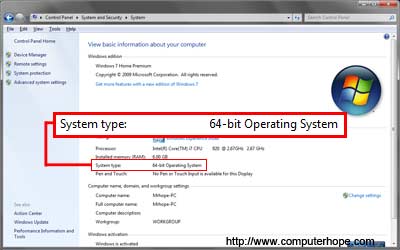How to Check if Computer Is 64 Bit
How to determine if you have a 32-bit or 64-bit CPU
Updated: 05/02/2021 by Computer Hope

The steps to determine whether your computer has a 32-bit or 64-bit processor (CPU) depend on the type of operating system installed. Below are the steps to determine the processor type for Windows, Mac, and Linux.
- Windows 8 and 10.
- Earlier versions of Windows.
- Determine if using 32-bit or 64-bit version of Windows
- Apple macOS.
- Linux.
Windows 8 and 10
To determine your CPU type and how many bits the processor has in Windows 8 and Windows 10, see the following steps.
- In the Windows search box, type system information and select the System Information icon.
Or, if you do not have a search box (because you have disabled it):
- Open a File Explorer window by pressing Windows key+E.
- On the left, right-click This PC.
- In the context menu, select Properties. The System Properties window opens.

- In the System Properties window, find your System type, which lists your operating system and CPU type.

Tip
To determine the manufacturer of the processor (e.g., AMD or Intel) and its model see the Processor line.
Earlier versions of Windows
With earlier versions of Windows, follow these steps.
- Open the Start menu > All Programs. Open the Accessories folder, then the System Tools folder. In the System Tools folder, select the System Information option.

On the right side of System Information, look for the System Type option under the Item column. The associated value, in the Value column, will tell you which type of CPU the computer has in it. If the System Type value includes "x86" in it, the CPU is 32-bit. If the System Type value includes "x64" in it, the CPU is 64-bit.
Determine if using 32-bit or 64-bit version of Windows
Microsoft Windows is available in 64-bit and 32-bit. 32-bit processors can only run 32-bit versions of Windows. However, 64-bit processors can run either the 64-bit or 32-bit versions.
To determine if the version of Windows on your computer is 32-bit or 64-bit, choose your version and follow the steps.
- Windows Vista, 7, 8, and 10
- Windows XP
- Windows 2000 and prior
Determine if Windows Vista, 7, 8 and 10 is 32-bit or 64-bit
- Press and hold the Windows key and the Pause key.
- In the System window, next to System type, it lists 32-bit Operating System for a 32-bit version of Windows, and 64-bit Operating System if you're running the 64-bit version. Below is a picture and an example of this window.

Determine if Windows XP is 32-bit or 64-bit
- Press and hold the Windows key and the Pause key, or open the System icon in the Control Panel.
- On the General tab of the System Properties window, if it has the text Windows XP, the computer is running the 32-bit version of Windows XP. If it has the text Windows XP Professional x64 Edition, the computer is running the 64-bit version of Windows XP.
Determine if Windows 2000 and prior is 32-bit or 64-bit
Windows operating systems, from Windows 95 to Windows 2000, are all 32-bit. There are no 64-bit versions of these operating systems.
Apple macOS
On the macOS, click the Apple icon in the menu bar. Select the About This Mac option in the Apple menu. On the About This Mac window, click the More Info option. Open the Hardware section and find the Processor Name attribute. Once listed, perform an Internet search, using that CPU's processor name as a keyword, to determine if it's a 32-bit or 64-bit CPU.
| Processor | 32-bit or 64-bit |
|---|---|
| Intel Core Duo or Solo | 32-bit |
| Intel Core 2 Duo | 64-bit |
| Any Intel Xeon processor | 64-bit |
| Intel Core i3 | 64-bit |
| Intel Core i5 | 64-bit |
| Intel Core i7 | 64-bit |
As shown in the table above, all the most recent Mac computers are 64-bit processors.
Linux
On the Linux operating system, access the command line interface and enter the following command.
grep flags /proc/cpuinfo
Look for "lm" in the command output. If lm is found in the output, then the CPU is 64-bit. If you don't see lm or see i386, i486, i586, or i686 in the output, then the CPU is 32-bit. Below is an example output of the command above with lm in the information.
flags : fpu vme de pse tsc msr pae mce cx8 apic sep mtrr pge mca cmov pat pse36 clflush dts acpi mmx fxsr sse sse2 ss ht tm pbe syscall nx lm constant_tsc arch_perfmon pebs bts rep_good pni monitor ds_cpl est tm2 ssse3 cx16 xtpr sse4_1 lahf_lm
Determine if the Linux kernel is 32-bit or 64-bit
Using the uname command, you can determine if your Linux kernel is 32-bit or 64-bit by running the command below.
uname -a
This command would give you output similar to the example output below.
SMP Tue Feb 12 00:15:43 EST 2008 x86_64 x86_64 GNU/Linux
If you see x86_64 in the output, this indicates it is x86 and that it is 64-bit.
How to Check if Computer Is 64 Bit
Source: https://www.computerhope.com/issues/ch001121.htm